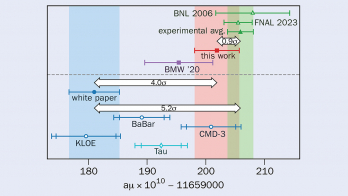By Tom Lancaster and Stephen J Blundell
Oxford University Press
Hardback: £65 $110
Paperback: £29.99 $49.95
Also available as an e-book, and at the CERN bookshop

Many readers of CERN Courier will already have several introductions to quantum field theory (QFT) on their shelves. Indeed, it might seem that another book on this topic has missed its century – but that is not quite true. Tom Lancaster and Stephen Blundell offer a response to a frequently posed question: What should I read and study to learn QFT? Before this text it was impossible to name a contemporary book suitable for self-study, where there is regular interaction with an adviser but not classroom-style. Now, in this book I find a treasury of contemporary material presented concisely and lucidly in a format that I can recommend for independent study.
Quantum Field Theory for the Gifted Amateur is in my opinion a good investment, although of course one cannot squeeze all of QFT into 500 pages. Specifically, this is not a book about strong interactions; QCD is not in the book, not a word. Reading page 308 at the end of subsection 34.4 one might expect that some aspects of quarks and asymptotic freedom would appear late in chapter 46, but they do not. I found the word “quark” once – on page 308 – but as far as I can tell, “gluon” did not make its way at all into the part on “Some applications from the world of particle physics.”
If you are a curious amateur and hear about, for example, “Majorana” (p444ff) or perhaps “vacuum instability” (p457ff, done nicely) or “chiral symmetry” (p322ff), you can start self-study of these topics by reading these pages. However, it’s a little odd that although important current content is set up, it is not always followed with a full explanation. In these examples, oscillation into a different flavour is given just one phrase, on p449.
Some interesting topics – such as “coherent states” – are described in depth, but others central to QFT merit more words. For example, figure 41.6 is presented in the margin to explain how QED vacuum polarization works, illustrating equations 41.18-20. The figure gives the impression that the QED vacuum-polarization effect decreases the Coulomb–Maxwell potential strength, while the equations and subsequent discussion correctly show that the observed vacuum-polarization effect in atoms adds attraction to electron binding. The reader should be given an explanation of the subtle point that reconciles the intuitive impression from the figure with the equations.
Despite these issues, I believe that this volume offers an attractive, new “rock and roll” approach, filling a large void in the spectrum of QFT books, so my strong positive recommendation stands. The question that the reader of these lines will now have in mind is how to mitigate the absence of some material.








